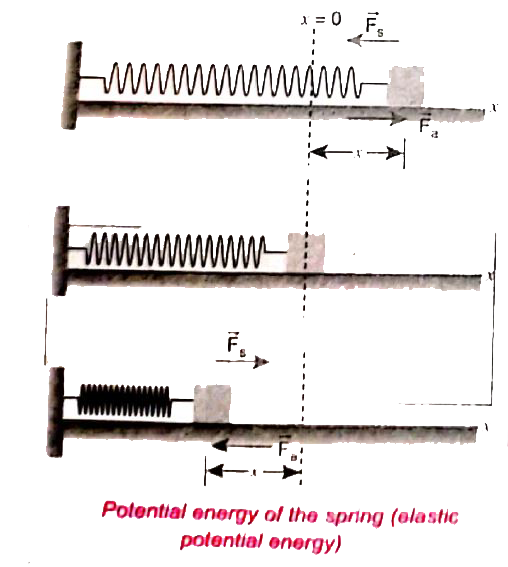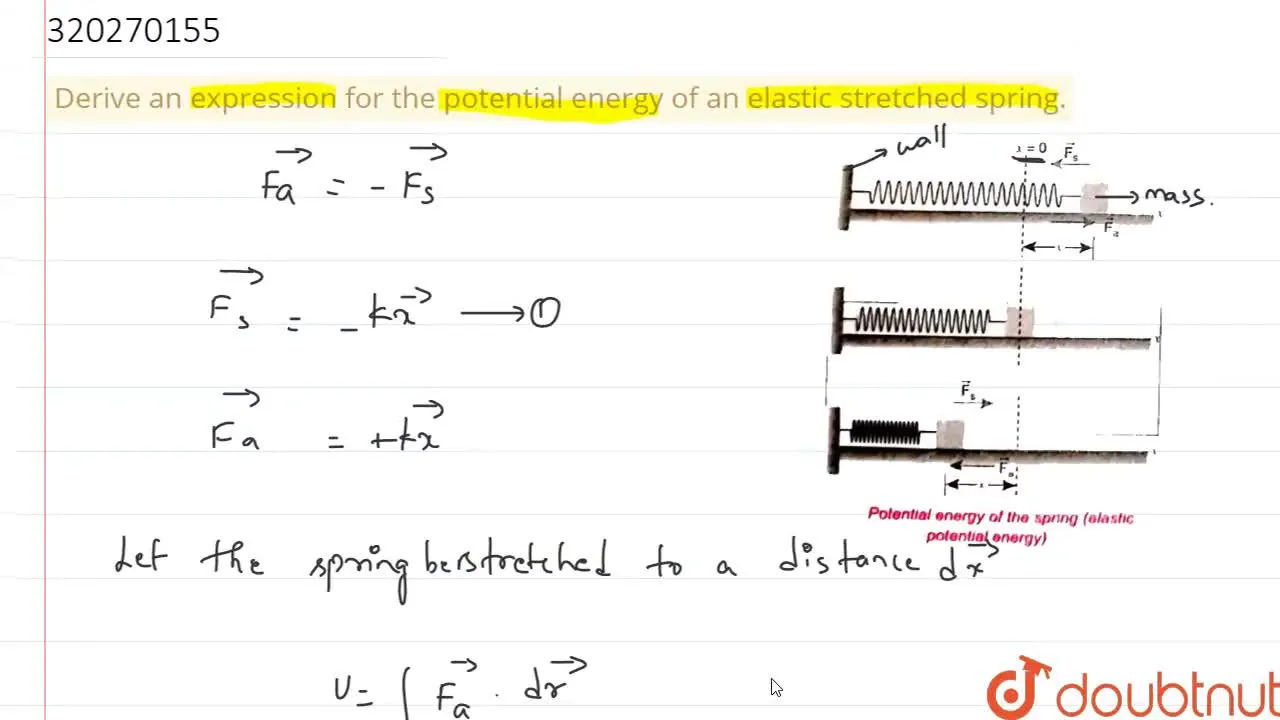Derive an expression for the potential energy of an elastic stretched spring. Solution in Tamil
Let us consider a spring-mass system. It is assumed that a mass, m lying on a smooth horizontal table as shown in the figure. Here, x=0 is the equilibrium position. One end of the spring is connected to a rigid wall and the other end to the mass.
Now an external force →Fa is applied so that it is stretched by a distance (x) in the direction of the force as long as the spring remains in equilibrium position. Its potential energy is zero.
A restoring force called spring force →FS is developed in the spring. It tries to bring the mass back to its original position. This applied force and the spring force are equal in magnitude but opposite in direction i.e., →Fa=−→Fs.

According to Hooke's law, the restoring force developed in the spring is given by
→Fs=−k→x ...(1)
The negative sign in the above expression implies that hte spring force is always opposite to that of displacement →xandk is the force constant. Hence applied force is →Fa=+k→x. It is implied from the positive sign, that the applied force is in the direction of displacement →. The spring force is an example of variable force as it depends on the displacement →x. Let the spring be stretched to a small distance d→x. The work done by the applied force on the spring to stretch it by a displacement x is stored as elastic potential energy.
U=∫→Fa.d→r=x∫0∣∣→Fa∣∣|d→r|cosθ
U=x∫0Fadxcosθ ...(2)
The applied force →Fa and the displacement dx are in the same direction. As, the initial position is taken as the equilibrium position or mean position, x=0 is the lower limit of integration.
U=x∫0kxdx ...(3)
U=k[x22]x0 ...(4)
U=12kx2 ...(5)
If the initial position is not zero, and if the mass is changed from position xi to xf, then the elastic potential energy is
U=12k(x2f−x2i) ...(6)
From equation (5) and (6), it is observed that the potential energy of the stretched spring depends on the force constant k and elongation or compression x.
Related Playlists
- BOOK - PREMIERS PUBLISHERSCHAPTER - WORK, ENERGY AND POWER EXERCISE - NUMERICAL PROBLEMS76videos
WORK, ENERGY AND POWER
- BOOK - PREMIERS PUBLISHERSCHAPTER - WORK, ENERGY AND POWER EXERCISE - CONCEPTUAL QUESTIONS34videos
WORK, ENERGY AND POWER
- BOOK - PREMIERS PUBLISHERSCHAPTER - WORK, ENERGY AND POWER EXERCISE - SHORT ANSWER QUESTIONS42videos
WORK, ENERGY AND POWER
- BOOK - PREMIERS PUBLISHERSCHAPTER - WAVESEXERCISE - OTHER IMPORTANT & QUESTIONS ANSWERS ( NUMERICAL PROBLEMS. )48videos
WAVES
Similar Questions
Calculate the work done by a force of 30 N in lifting load of 2g to a height of 10 m (g=10ms−2).
03:50View SolutionA spring which is initially in un-streatched condition, is first stretched by a length x and again by a further length x. The work done in the first case W1 is one third of the work done in second case W2. True of false ?
06:33View SolutionExplain how the definition of work in physics is different from general perception.
09:40View SolutionThe equation of a wave is,
y(x,t)=0.05sin[π2(10x−40t)−π4]m Find,
The wavelength, the frequency and the wave velocity.
(ii) The particle velocity and acceleration at x=0.5 m and t=0.05 s.08:56View SolutionA long elastic spring is stretched by 2 cm and its potential energy is U . If the spring is stretched by 10 cm , the PE …… will be
06:33View SolutionDerive an expression for the potential energy of an elastic stretched spring.
View SolutionDerive the expression for gravitational potential energy.
04:27View SolutionDerive an expression for potential energy of a spring and show that spring force is a conservation force.
03:09View SolutionDerive an expression for the potential energy of an elastic stretched spring.
04:50View SolutionWrite down the expression for the elastic potential energy of a stretched wire.
07:16View SolutionWrite down the expression for the elastic potential energy of a stretched wire .
02:11View SolutionDerive an expression for the potential energy of a stretched spring .
03:39View SolutionA spring of spring constant k is stretched by distance r. Obtain formula for elastic potential energy of a stretched spring. Plot graph of energies versus distance.
02:15View SolutionDerive an expression for the potential energy of an elastic stretched spring.
06:00View SolutionDerive an expression for the elastic potential energy stored in a stretched wire under stress.
View Solution


